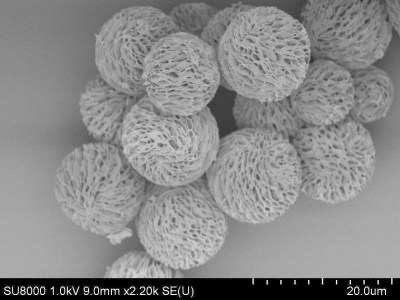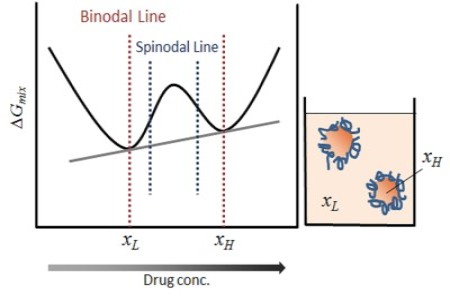Development of Mesoporous Particles Composed Solely of Phospholipids
We have developed a technology to prepare mesoporous particles using solely phospholipids. This particle can be manufactured only by freeze-drying; therefore, scale-up is expected to be easy. Because of its biocompatible property, it is expected to be used as a DDS carrier. Unlike liposomes, this particle is suitable to solid dosage forms. We have loaded fenofibrate, a poorly soluble drug, to observe improvement in oral absorption. This effect was based on totally novel mechanism, where coarse mixed micelles were formed through interaction between particles and bile acids to help drug molecules to be absorbed.
“Totally Phospholipidic Mesoporous Particles”
S. Zhang, K. Kawakami, et al., J. Phys. Chem. C 119, 7255-7263 (2015).
“Physicochemical Properties of Solid Phospholipid Particles as a Drug Delivery Platform for Improving Oral Absorption of Poorly Soluble Drugs”
K. Kawakami et al., Pharm. Res. 34, 208-216 (2017).
“Totally Phospholipidic Mesoporous Particles”
S. Zhang, K. Kawakami, et al., J. Phys. Chem. C 119, 7255-7263 (2015).
“Physicochemical Properties of Solid Phospholipid Particles as a Drug Delivery Platform for Improving Oral Absorption of Poorly Soluble Drugs”
K. Kawakami et al., Pharm. Res. 34, 208-216 (2017).

Non-Equilibrium Dynamics of Low-Molecular-Weight Organic Glasses
Inorganic glasses, which are formed by strong molecular interaction, are of major interest in the research of glass dynamics. A different viewpoint is required for organic glasses, because weak interactions such as hydrogen-bond and van der Waals force also participate in formation of the glass structure. We are observing non-equilibrium dynamics of pharmaceutical glasses. Crystallization rate of the pharmaceutical glasses is usually discussed on a case by-case basis, but it was explained only by the glass transition temperature under precisely controlled environments. Some compounds, of which weak molecular interactions play important role to maintain the glass structure, were successfully stabilized by intentional annealing that influences free volume and hydrogen bond strength. Also investigated is supersaturation behavior which can be observed during dissolution of pharmaceutical glasses. The supersaturated solution causes phase separation into concentrated and diluted phases. The phase separation concentration was found to correlate well with degree of oral absorption of the drug.
“Relationship between Crystallization Tendencies during Cooling from Melt and Isothermal Storage: Toward a General Understanding of Physical Stability of Pharmaceutical Glasses”
K. Kawakami et al., Mol. Pharmaceutics 11, 1835-1843 (2014).
“Correlation between Glass Forming Ability and Fragility of Pharmaceutical Compounds”
K. Kawakami, T. Harada, Y. Yoshihashi, E. Yonemochi, K. Terada, H. Moriyama, J. Phys. Chem. B 119, 4873–4880 (2015).
“Phase Separation of Supersaturated Solution Created from Amorphous Solid Dispersions: Relevance to Oral Absorption”
K. Kawakami, K. Sato, M. Fukushima, A. Miyazaki, Y. Yamamura, S. Sakuma, Eur. J. Pharm. Biopharm. 132, 146-156 (2018).
“Crystallization Tendency of Pharmaceutical Glasses: Relevance to Compound Properties, Impact of Formulation Process, and Implications for Design of Amorphous Solid Dispersions”
K. Kawakami, Pharmaceutics, 11, 202 (2019).
“Impact of Degree of Supersaturation on the Dissolution and Oral Absorption Behaviors of Griseofulvin Amorphous Solid Dispersions”
K. Kawakami, K. Suzuki, M. Fukiage, M. Matsuda, Y. Nishida, M. Oikawa, T. Fujita, J. Drug Delivery Sci. Technol., 56, 101172 (2020).
“Relationship between Crystallization Tendencies during Cooling from Melt and Isothermal Storage: Toward a General Understanding of Physical Stability of Pharmaceutical Glasses”
K. Kawakami et al., Mol. Pharmaceutics 11, 1835-1843 (2014).
“Correlation between Glass Forming Ability and Fragility of Pharmaceutical Compounds”
K. Kawakami, T. Harada, Y. Yoshihashi, E. Yonemochi, K. Terada, H. Moriyama, J. Phys. Chem. B 119, 4873–4880 (2015).
“Phase Separation of Supersaturated Solution Created from Amorphous Solid Dispersions: Relevance to Oral Absorption”
K. Kawakami, K. Sato, M. Fukushima, A. Miyazaki, Y. Yamamura, S. Sakuma, Eur. J. Pharm. Biopharm. 132, 146-156 (2018).
“Crystallization Tendency of Pharmaceutical Glasses: Relevance to Compound Properties, Impact of Formulation Process, and Implications for Design of Amorphous Solid Dispersions”
K. Kawakami, Pharmaceutics, 11, 202 (2019).
“Impact of Degree of Supersaturation on the Dissolution and Oral Absorption Behaviors of Griseofulvin Amorphous Solid Dispersions”
K. Kawakami, K. Suzuki, M. Fukiage, M. Matsuda, Y. Nishida, M. Oikawa, T. Fujita, J. Drug Delivery Sci. Technol., 56, 101172 (2020).

Phospholipid Bilayers on Solid Surfaces
We investigate the mechanisms of vesicle adsorption on solid surfaces and the properties of supported bilayers.
- "Packing Density Changes of Supported Lipid Bilayers Observed by Fluorescence Microscopy and Quartz Crystal Microbalance-Dissipation"
C. Kataoka-Hamai, M. Higuchi, J. Phys. Chem. B 118 (2014) 10934-10944. - "Induced Rupture of Vesicles Adsorbed on Glass by Pore Formation at the Surface–Bilayer Interface"
C. Kataoka-Hamai, T. Yamazaki, Langmuir 31 (2015) 1312–1319. - "Binding of Lipopolysaccharide and Cholesterol-Modified Gelatin on Supported Lipid Bilayers: Effect of Bilayer Area Confinement and Bilayer Edge Tension"
C. Kataoka-Hamai, Y. Kaizuka, T. Taguchi, Langmuir 32 (2016) 1250-1258. - "Domain Sorting in Giant Unilamellar Vesicles Adsorbed on Glass"
C. Kataoka-Hamai, K. Kawakami, Langmuir 37 (2021) 1082-1088.
Phospholipid Monolayers at Oil-Water Interfaces
We investigate the mechanisms of vesicle adsorption on oil-water interfaces and the structures and properties of interfacial phospholipid monolayers.
- "Interaction Mechanisms of Giant Unilamellar Vesicles with Hydrophobic Glass Surfaces and Silicone Oil–Water Interfaces: Adsorption, Deformation, Rupture, Dynamic Shape Changes, Internal Vesicle Formation, and Desorption"
C. Kataoka-Hamai, K. Kawakami, Langmuir 35 (2019) 16136–16145. - "Determination of the Coverage of Phosphatidylcholine Monolayers Formed at Silicone Oil–Water Interfaces by Vesicle Fusion"
C. Kataoka-Hamai, K. Kawakami, J. Phys. Chem. B 124 (2020) 8719–8727. - "Determining the Dependence of Interfacial Tension on Molecular Area for Phospholipid Monolayers Formed at Silicone Oil-Water and Tricaprylin-Water Interfaces by Vesicle Fusion"
C. Kataoka-Hamai, K. Kawakami, Langmuir 37 (2021) 7527–7535.

